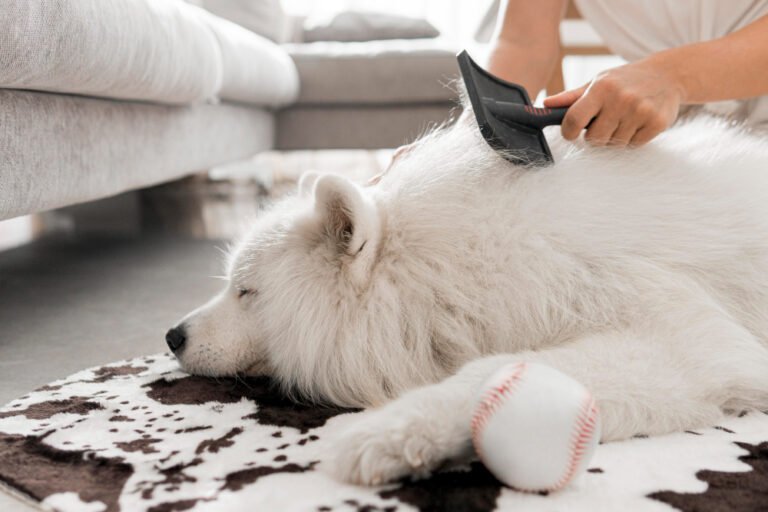The Connection Between Exercise and Mental Health in Pets
Regular exercise is not only beneficial for humans, but also for our furry friends. In fact, exercise plays a crucial role in the mental health and well-being of pets. Not only does it improve their overall mental health, but it also helps reduce anxiety and stress, enhances cognitive function, and increases bonding and socialization. By choosing the right exercises, incorporating them into their routine, and recognizing the signs of a mentally healthy pet, we can ensure that our pets lead happy and fulfilling lives. Here are the key takeaways from this article:
Key Takeaways
- Regular exercise improves the mental health of pets.
- Exercise helps reduce anxiety and stress in pets.
- Engaging in physical activities enhances cognitive function in pets.
- Exercise promotes bonding and socialization among pets and their owners.
- Choosing the right exercises and recognizing the signs of a mentally healthy pet are essential.
The Benefits of Exercise for Pets

Improved Mental Health
Regular exercise has a significant impact on your pet’s mental health. It helps to reduce feelings of loneliness, anxiety, and depression, and can even alleviate symptoms of PTSD. The increased activity that comes with exercise not only improves physical health but also boosts mental well-being. Whether it’s going for a brisk walk in the fresh air or engaging in interactive exercises like playing fetch, these activities contribute to improved mental health. By incorporating exercise into your pet’s routine, you are providing them with the opportunity to release pent-up energy and stimulate their mind.
Reduced Anxiety and Stress
Pets, particularly common ones like dogs and cats, can biologically and psychologically help alleviate human stress levels and anxieties. The companionship they offer reminds us that we are not alone and that they need us. Taking them on walks and sticking to a routine for them physically helps our stress levels stay low, provides exercise, and a change of scenery. Additionally, caring for a pet encourages mindfulness as individuals focus on the present moment while attending to their pet’s needs, promoting a break from stressors. Pets also offer unconditional love and acceptance, creating a source of emotional support for their owners. The presence of a pet can alleviate symptoms of anxiety, providing a calming effect and helping individuals cope with daily challenges. Interacting with pets triggers the release of neurotransmitters like dopamine and serotonin, which can increase feelings of happiness and well-being.
Enhanced Cognitive Function
Regular exercise not only benefits your pet’s physical health, but it also plays a crucial role in enhancing cognitive function. Engaging in activities that challenge your pet’s mental abilities can help stimulate their brain and improve their overall cognitive skills. Problem-solving, memory, and learning are all areas that can be positively influenced by exercise.
To promote cognitive function in your pet, you can incorporate interactive toys and games into their routine. These toys provide mental stimulation and encourage your pet to think and problem-solve. Additionally, training sessions that involve commands and tricks can also help exercise your pet’s brain.
It’s important to note that exercise and positive relationships in dogs go hand in hand. Spending quality time with your pet and engaging in activities together not only strengthens your bond but also provides mental stimulation for both you and your furry friend. So, make sure to include activities that promote socialization and bonding in your exercise routine with your pet.
Increased Bonding and Socialization
Interacting with your pet through exercise not only strengthens your bond but also enhances their socialization skills. Regular exercise provides opportunities for your pet to interact with other animals and humans, promoting positive social interactions and reducing behavioral problems. Whether it’s playing fetch at the park or going for a walk in the neighborhood, these activities encourage focus and obedience in dogs while allowing them to meet new friends. By engaging in exercise together, you create a shared experience that deepens your connection and fosters a sense of companionship.
Choosing the Right Exercise for Your Pet

Consider Your Pet’s Breed and Size
Besides keeping your pet in shape, exercise acts as the equalizer against all bad behaviors, helping to keep a variety of problems—like inappropriate elimination, anxiety, eating disorders, attention seeking, aggression, and barking—at bay. How much exercise a pet needs can vary greatly depending on factors like age, breed, weight, and health status, but the best place to start for any dog is a daily walk. Many pet owners believe dogs that have regular access to a large yard will naturally entertain themselves, but this is not true. A large yard to a dog is just the equivalent of a large bathroom. Regular walks and play sessions are key.
Tailoring Exercise to Your Pet’s Abilities
When it comes to tailoring exercise to your pet’s abilities, it’s important to consider their individual needs and limitations. Relax and take the time to assess what types of activities are suitable for your furry friend. If your pet is older or has health issues, low-impact exercises like gentle walks or swimming can be a great option. On the other hand, if your pet is energetic and full of energy, more vigorous activities like running or playing fetch may be more appropriate. Remember to always start slow and gradually increase the intensity and duration of the exercise. This will help prevent injuries and ensure that your pet enjoys the activity. Additionally, it’s crucial to pay attention to any signs of discomfort or fatigue during the exercise and adjust accordingly. Your pet’s well-being should always be the top priority.
Variety is Key
When it comes to exercise for your pet, variety is key. Offering a range of different activities not only keeps things interesting for your furry friend, but it also provides mental stimulation and helps prevent boredom. Mixing up the types of exercise your pet engages in can also target different muscle groups and provide a well-rounded workout.
To ensure your pet gets the most out of their exercise routine, consider incorporating a combination of indoor and outdoor activities. Indoor activities such as puzzle toys, interactive games, and hide-and-seek can keep your pet entertained and mentally engaged, especially during bad weather or when you’re short on time. Outdoor activities like walks, runs, and playtime at the park allow your pet to explore their surroundings, socialize with other animals, and burn off excess energy.
Remember to tailor the exercise to your pet’s individual needs and abilities. Some pets may require more intense exercise, while others may have physical limitations that need to be taken into account. Always consult with your veterinarian to determine the best exercise plan for your pet’s specific breed, age, and health condition.
Incorporating convenient pet feeding into your pet’s routine can also be a great way to provide mental stimulation and exercise. Using puzzle feeders or food-dispensing toys can make mealtime more engaging and challenging for your pet, encouraging them to work for their food and keeping their minds active.
Remember, the key is to keep things fun and engaging for your pet while also promoting their mental and physical well-being. By offering a variety of activities and tailoring them to your pet’s needs, you can ensure they stay happy, healthy, and mentally stimulated.
Safety Precautions for Outdoor Activities
When engaging in outdoor activities with your pet, it’s important to prioritize their safety and well-being. Here are some key points to keep in mind:
-
Whisker Wellbeing: Ensure that your pet’s whiskers are not obstructed or restricted during outdoor activities. Whiskers play a crucial role in a pet’s sensory perception, helping them navigate their surroundings and detect potential dangers.
-
Proper Leash Usage: Always use a sturdy leash that is appropriate for your pet’s size and strength. This will help you maintain control and prevent your pet from running into hazardous situations.
-
Weather Considerations: Take into account the weather conditions before heading outdoors. Extreme heat or cold can be harmful to your pet’s health. Provide adequate shade and water on hot days, and consider using protective gear such as booties or jackets in cold weather.
-
Identification and Vaccinations: Make sure your pet is wearing proper identification tags with up-to-date contact information. Additionally, ensure that your pet’s vaccinations are current to protect them from potential diseases they may encounter during outdoor activities.
Remember, the safety and well-being of your pet should always be your top priority when enjoying outdoor activities together.
Incorporating Exercise into Your Pet’s Routine

Establishing a Regular Exercise Schedule
Besides keeping your pet in shape, exercise acts as the equalizer against all bad behaviors, helping to keep a variety of problems—like inappropriate elimination, anxiety, eating disorders, attention seeking, aggression, and barking—at bay. How much exercise a pet needs can vary greatly depending on factors like age, breed, weight, and health status, but the best place to start for any dog is a daily walk. Many pet owners believe dogs that have regular access to a large yard will naturally entertain themselves, but this is not true. A large yard to a dog is just the equivalent of a large bathroom. Regular walks are essential, as they give your dog the opportunity to explore his/her surroundings and work on behavior skills, such as mastering commands like sit and stay, while warding off physical problems like canine obesity. All dogs should walk, run, or simply sniff around between one-half and four miles per day. Very active breeds, like Pointers, Vizslas, Standard Poodles, and other thin, well-muscled dogs, are commonly “four mile per day” dogs.
Fun and Engaging Indoor Activities
Indoor activities are a great way to keep your pet entertained and mentally stimulated, especially when the weather is not ideal for outdoor adventures. Cat owners can engage their feline friends with interactive toys that encourage hunting and pouncing. You can also create a stimulating environment by setting up a cat tree or providing scratching posts for them to explore. Another fun activity is playing hide and seek with treats or toys, which taps into their natural curiosity and keeps them engaged. Additionally, consider setting up a cozy spot near a window where your cat can observe the outside world and enjoy the sights and sounds of nature.
Outdoor Adventures for Active Pets
Outdoor adventures are a great way to keep your active pet engaged and mentally stimulated. Exploring new environments and encountering different sights, sounds, and smells can provide a valuable sensory experience for your furry friend. Whether it’s a hike through a scenic trail, a visit to a dog-friendly beach, or a trip to a local park, outdoor adventures offer a variety of benefits for your pet’s mental health.
Exploring Nature: Taking your pet to a garden or arboretum can be a wonderful outdoor adventure. They can spot wildlife, listen to birdsong, and enjoy the fresh air and natural surroundings.
Socializing with Other Dogs: Visiting a dog park allows your pet to interact with other dogs and engage in playful activities. It’s a great opportunity for them to make new friends and improve their socialization skills.
Bonding Time: Outdoor adventures provide an excellent opportunity for you to bond with your pet. Spending quality time together in nature strengthens your relationship and creates lasting memories.
Physical Exercise: Outdoor activities like hiking, running, or playing fetch provide your pet with the physical exercise they need to stay healthy and maintain a balanced lifestyle.
Safety First: When planning outdoor adventures, make sure to prioritize your pet’s safety. Keep them on a leash when necessary, provide plenty of water and shade, and be aware of any potential hazards in the environment.
Remember, outdoor adventures are not only beneficial for your pet’s mental health but also for their overall well-being. So, grab a leash, put on your walking shoes, and embark on exciting outdoor adventures with your furry companion!
Interactive Toys and Games
Interactive toys and games are a great way to keep your pet mentally stimulated and entertained. These toys provide enrichment and mental exercise for your pet, helping to prevent boredom and destructive behaviors. They also promote problem-solving skills and cognitive development. Some popular interactive toys for pets include puzzle toys, treat-dispensing toys, and interactive balls. These toys require your pet to use their natural instincts and problem-solving abilities to retrieve treats or solve puzzles. They provide a fun and engaging way for your pet to stay active and mentally sharp. Additionally, interactive games such as hide-and-seek or fetch can also provide mental stimulation and strengthen the bond between you and your pet. Remember to choose toys that are safe and appropriate for your pet’s size and breed. Regularly rotate the toys to keep the playtime exciting and prevent boredom. By incorporating interactive toys and games into your pet’s routine, you can provide them with effective solutions for mental stimulation and ensure they lead a happy and fulfilling life.
Signs of a Mentally Healthy Pet

Energetic and Playful Behavior
Energetic and playful behavior is a clear indication of a mentally healthy pet. When your pet is full of energy and always ready to play, it shows that they are in a positive state of mind. Exercise plays a crucial role in promoting this behavior by providing an outlet for their energy and stimulating their mind. Regular exercise helps to reduce anxiety and stress, which can often manifest as destructive behavior or excessive barking. By engaging in physical activity, your pet can release pent-up energy and feel more relaxed.
To ensure that your pet stays mentally healthy, it is important to provide them with adequate exercise. This can include activities such as daily walks, play sessions, or interactive games. Tailor the exercise to your pet’s breed, size, and abilities to ensure that they are getting the right amount of physical and mental stimulation. Remember, a tired pet is a happy pet!
In addition to promoting energetic and playful behavior, exercise also has numerous health benefits for your pet. It helps to maintain a healthy weight, improve cardiovascular health, and reduce the risk of chronic conditions. Regular exercise can also strengthen their muscles and joints, improving their overall mobility and quality of life.
To summarize, energetic and playful behavior is a positive sign of your pet’s mental well-being. By providing them with regular exercise, you are not only promoting their physical health but also enhancing their mental and emotional state. So, get out there and have fun with your furry friend!
Good Appetite and Sleep Patterns
Having a good appetite and healthy sleep patterns are important indicators of your pet’s mental well-being. A pet with a healthy appetite is likely to be happy and content. If your pet is eating well, it shows that they are enjoying their meals and are not experiencing any physical discomfort or stress. Similarly, a pet with regular and restful sleep patterns is more likely to be mentally balanced and relaxed. Adequate sleep allows your pet’s body and mind to recharge, promoting overall well-being.
To ensure that your pet maintains a good appetite and healthy sleep patterns, it is important to provide them with a balanced diet and a comfortable sleeping environment. Make sure to offer nutritious meals that meet their dietary needs and preferences. Additionally, create a cozy and quiet space for your pet to sleep, free from distractions and excessive noise. Establishing a consistent feeding and sleeping routine can also contribute to maintaining good appetite and sleep patterns.
Tips for promoting a good appetite and healthy sleep patterns:
- Provide a balanced and nutritious diet
- Create a comfortable sleeping environment
- Establish a consistent feeding and sleeping routine
- Minimize stress and distractions during mealtime and bedtime
- Monitor your pet’s eating and sleeping habits for any changes or abnormalities
Remember, a pet with a good appetite and healthy sleep patterns is likely to be happier and more mentally balanced. Pay attention to these indicators and make adjustments to their routine or diet if needed.
Positive Interactions with Humans and Other Animals
Positive interactions with humans and other animals are essential for the mental well-being of your pet. Interacting with humans helps to build trust and strengthen the bond between you and your furry friend. It provides them with a sense of security and affection, knowing that they can rely on you for their needs. Similarly, interacting with other animals allows your pet to engage in socialization and develop important social skills.
To ensure positive interactions, it is important to create a safe and welcoming environment for your pet. Provide them with opportunities to interact with other friendly animals and supervise their interactions to prevent any conflicts or harm. Additionally, consider their comfort level and introduce new interactions gradually to avoid overwhelming them.
Remember, positive interactions with humans and other animals contribute to the overall mental health and happiness of your pet. By fostering these interactions, you are creating a supportive and enriching environment for your furry companion.
Ability to Adapt to New Environments
When it comes to your pet’s ability to adapt to new environments, exposure and socialization play key roles. Introducing your pet to different environments from an early age can help them become more comfortable and confident in new situations. This can be done by taking them on regular outings to parks, pet-friendly stores, or even on car rides. Positive reinforcement and reward-based training can also be effective in helping your pet adapt to new environments. By providing treats and praise when they exhibit calm and relaxed behavior in new surroundings, you can reinforce their confidence and reduce any anxiety they may feel.
To further support your pet’s ability to adapt, it’s important to create a safe and secure environment for them. This includes providing a designated space for them to retreat to when they feel overwhelmed, such as a cozy bed or crate. Additionally, routine and consistency in their daily activities can help them feel more at ease in new environments. Stick to a regular feeding and exercise schedule, and provide them with familiar toys and objects that carry their scent.
Here are some tips to help your pet adapt to new environments:
- Gradually introduce them to new environments, starting with low-stress situations and gradually increasing the level of exposure.
- Use positive reinforcement and reward-based training to encourage calm and relaxed behavior.
- Provide a safe and secure space for them to retreat to when they feel overwhelmed.
- Stick to a routine and consistency in their daily activities.
Remember, every pet is unique, and it may take time for them to adjust to new environments. Patience, understanding, and gentle guidance are key in helping them feel comfortable and confident wherever they go.
Signs of a Mentally Healthy Pet
Conclusion
In conclusion, the connection between exercise and mental health in pets is undeniable. Not only do pets improve our physical health, but they also have a positive impact on our mental well-being. The increased activity that comes with owning a pet can help alleviate feelings of loneliness, anxiety, and depression. Engaging in activities like walking, playing, and spending time outdoors with our pets can lower stress levels and release feel-good chemicals in our brains. Additionally, pets provide us with a sense of purpose and companionship, contributing to our overall happiness and well-being. So, if you’re looking to improve your mental health, consider incorporating regular exercise and quality time with your furry friend into your routine. Your pet will thank you, and you’ll reap the benefits too!
Frequently Asked Questions
How does exercise improve mental health in pets?
Exercise helps release feel-good chemicals in the brain, such as dopamine and oxytocin, which can lower stress and improve mood in pets.
What are the benefits of exercise for pets?
Exercise can improve mental health, reduce anxiety and stress, enhance cognitive function, and increase bonding and socialization in pets.
How can I choose the right exercise for my pet?
Consider your pet’s breed and size, tailor exercise to their abilities, provide variety, and take safety precautions for outdoor activities.
How often should I exercise my pet?
It is recommended to establish a regular exercise schedule for your pet, but the frequency may vary depending on their age, breed, and health condition.
What are some fun indoor activities for pets?
You can engage your pet with interactive toys, play hide-and-seek, set up obstacle courses, or try indoor agility exercises.
Are there any safety precautions for outdoor activities with pets?
When engaging in outdoor activities with your pet, make sure to keep them on a leash, provide proper supervision, protect them from extreme weather conditions, and be aware of potential hazards.







